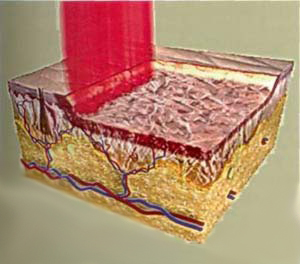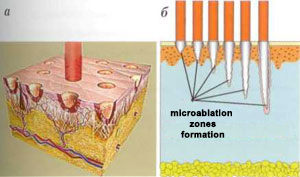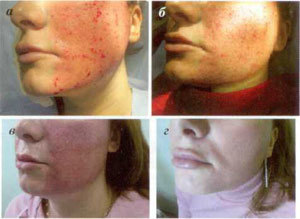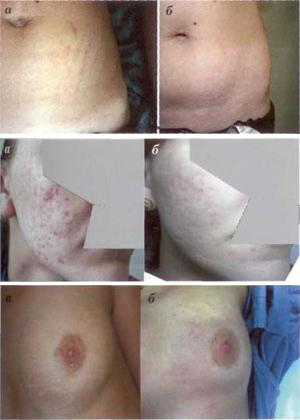This trend is particularly typical for hardware methods, primarily for laser medicine. There is a significant period in the use of lasers, first in dermatology, and then in cosmetology. Even since the advent of one of the most innovative methods of laser treatment - selective photothermolysis - has passed after more than 25 years. The pioneers of this guide, the Americans RR Anderson and JA Parrish, previously predicted the fate of fractional lasers in medicine, making them indispensable in the aesthetic treatment of such skin synapses as capillary hemangiomas. Port wine stains, hypertrophy, tattoos, rosacea, pigmentation disorders, photography, wrinkles, etc.
Modern skin reshaping techniques
We live in a time when more people are living to old age than ever before. And since many of them continue to live an active life, one of the most important problems in aesthetic medicine is the fight against aging skin.
Plastic surgery can restore a person's shape by removing excess skin. At the same time, however, the skin is still altered by time (age-related aging) or external factors (photography). It is also important that the majority of younger otorams need no surgery.
In this case, what method should be used to influence the skin and what should happen there to really rejuvenate it?
All methods that can be used to improve the appearance of the skin are united by one principle - they use a traumatic effect on the skin, stimulating fibrosis, which increases its tension and compression.
Currently, dermatocosmetology uses three main types of remodeling effects on the skin, including:
- Chemical peels
- - chemical peels with acids (trichloroacetic, glycolic, etc. ); Mechanical stimulation
- - mechanical dermabrasion, microdermabrasion, mesotherapy, fillers, subcision with needles; Thermal stimulation
- - laser ablation, thermalization with lasers and broadband light sources, radio frequency rise, fractional methods.
Chemical stimulation
Historically, acid exfoliation (peeling) was the first method to rejuvenate skin. The principle of peeling is partial destruction (as with surface peeling) or almost complete destruction (as in middle and deep peeling) of the epidermis, damaging the fibroblasts and dermis. This damage activates an inflammatory reaction (the more powerful, the greater the amount of self-destruction), which leads to further production of collagen in the skin.
To achieve the desired result, however, peeling of the epidermis must be sacrificed. Experiments with burns have misled many people, allegedly proving “that the epidermis is a self-regenerating organ that recovers rapidly across the damaged area. In this regard, skin has become more and more aggressive towards the epidermis (e. g. , deep phenolic peeling), until the accumulated problems eventually realize that this is crucial. a method that eventually leads to thinning of the skin.Deep skinners have ignored the emerging problems. Their essence was that due to the destruction of the papillae of the dermis and the weakening of the nourishment, the epidermis becomes thinner, and the number of cells in the prickly layer is significantly reduced compared to what existed before peeling. Decreased barrier function of the stratum cornea results in decreased hydration of the skin. (Therefore, almost all patients experience severe dryness of the skin after deep peeling for a long time) At the same time, it is practically introduced that lighter peels (using trichloroacetic acids and fruits) were up to theirhope to tighten the skin effectively.
Mechanical stimulation
Of the methods for mechanical stimulation of nonspecific changes in the skin, dermabrasion deserves special attention with the use of rotating devices (with speed v; rotation of cutters up to 100, 000 rpm). Currently, modern Schumann-Schreus devices (Germany)
are usedThe method can only be used in a surgical hospital, as the anesthesia procedure requires postoperative treatment of the wound surface, special toilet for the eyes and mouth, as well as devices for the patient. feeding (because it is difficult to open the eyes and mouth due to pronounced postoperative edema that occurs 2-3 days after the procedure).
The method is very effective, but, unfortunately, with mechanical dermabrasion there is a high risk of complications such as:
- persistent postoperative hyperemia;
- the appearance of depleted areas due to destruction of melanocytes when the cutter passes through the basement membrane; Wound surface infection
- ; scarring
- (if the cutter is immersed too deep in the skin)
All of the above have determined the limited application of this method in clinical practice.
Thermal stimulation
Relative Remodeling
Since the late 1980s, lasers have been used to rejuvenate the skin by removing layer-by-layer tissue (ablation) [4]. Careful, low-traumatic removal of the surface layer of the skin with a carbon dioxide laser stimulates the synthesis of its own collagen, which increases in size a few times after the procedure. It is then gradually reorganized.
The most effective was the use of a CO2 laser, when exposed to a deep thermal effect on each layer of the dermis, externally manifested by a skin tightening effect. The “resurfacing” is called “laser dermabrasion”, and “in terms of efficacy” it could not be resisted by any other method of skin rejuvenation that existed at that time (Fig. 1).

True. 1. Conventional laser skin resurfacing scheme (laser dermabrasion)
However, the CO2 laser also creates a large number of complications. In addition, further studies have shown that such a deep effect on the dermis stimulates the formation of fibrous tissue more than it contributes to new normal synthesis. collagen concentrated [5]. Developmental fibrosis can make the skin look unnatural. Collagen is synthesized after repositioning treatment after a few years, like any collagen formed at the site of the scar. Thinning of the epidermis due to atrophy of the papillary layer of the dermis, smooth wrinkles begin to appear on the skin. Due to the weakening of the barrier function of the stratum cornea, the hydration level of the skin decreases, and it has an atrophic appearance.Garnet-erbium erbium-aluminum-yttrium lasers appeared a little later. Such advantages of an erbium laser as a shallow thermal penetration depth (erbium lasers go to a depth of 30 μm, CO2 lasers - up to 150 μm) and (as a result) drew less risk from burning and carbonization of tissue, as well. relative to the relative cheapness (compared to carbon dioxide lasers), the attention of many specialists around the world. However, as experience of working with these two types of installation has accumulated, the view among specialists that CO2 lasers are more efficient [6]. Despite the negative effects of carbon dioxide laser dermabrasion described above, the scavenging method is indispensable for correcting acne scars. In addition, it can be considered as an alternative to surgical skin tightening - of all the remodeled methods, only exposure to a CO2 laser can actually cause collagen shrinkage with a clinically visible lifting effect.
The problem with all the methods described above is that they often "sacrifice", that is, do great damage to the epidermis. In order to rejuvenate your skin and look really young, you naturally need a perfect epidermis of the dermal papillae, good hydration, normal skin tone and elasticity. The epidermis is a highly complex, highly specialized organ, up to 200 microns thick, which is our only protection against the effects of negative environmental factors. Therefore, whatever we do to rejuvenate the skin, we must ensure that its normal basic architecture is never damaged.
This concept contributed to the advent of non-genetic skin remodeling technology.
Non-ablative remodeling
The most common devices for non-genetic skin remodeling are neodymium (Nd-YAG) and diode lasers, as well as broadband light sources (IPL). The principle of their action - selective photothermolysis - is heating and destruction of structures, which contain a lot of melanin or oxyhemoglobin. In the skin, these are, respectively, the accumulation of melanocytes (lentigo, melasma) and microvessels (telangiectasia). The emission wavelengths used in non-abrasive lasers correspond to the maximum absorption spectrum of oxyhemoglobin or melanin. The procedure for treatment with non-abrasive lasers and IPL is quite safe, the recovery period is minimal, however, such treatment only eliminates cosmetic pigment and vascular defects. In this case, there is a certain thickening of the skin, but the effect obtained is short-lived.
Fractional Skin Remodeling Techniques
The constant search for new highly effective and safe methods at the same time as skin rejuvenation has led to the emergence of a revolutionary technology - fractional delivery of laser radiation. The specially designed skin rejuvenation method is designed to overcome some of the above difficulties. Unlike “traditional” abiotic and non-abrasive laser methods, which are designed to achieve uniform thermal damage to the skin at specific depths, fractional methods allow to achieve its selective microscopic thermal damage in the form of many altered columns and unaffected areas. leave them around these micro-wounds. Currently, the industry produces two types of fractional lasers: non-ablative and ablative.
The first uses an erbium doped optical fiber that generates radiation at a wavelength of 1550 nm. Fractional lasers in the skin form thousands and thousands and thousands of microdamages in the form of columns - microthermal treatment zones (MLZ) - with a diameter of 70-150 mk up to 1359 mcm
As a result, the treated area has about 15-35 photocopied skins. Water is the chromatometer for the laser. Coagulation occurs primarily in the lower layers of the epidermis and dermis. The coil of the stratum remains intact because it contains a relatively small amount of water, which significantly reduces the risk of infection. Epidermal recovery is rapid due to the low lesion size and short migration length of keratinocytes. The healing period is accompanied by moderate leukemia and hyperemia, followed by desquamation, appearing on the 5-7th day. Practically the patient does not miss social activity.
This technology - fractional photothermolysis (FF) - is a very effective method for reshaping non-ablative fractional resorption. To achieve the desired effect, course treatment is prescribed. Depending on the clinical situation, it is recommended to perform from 3 to 6 procedures with an interval of 4-6 weeks. As with any other method of reshaping non-abrasive skin, the final result can only be seen 4-8 months after the procedure (cumulative effect).

In cases where a more aggressive effect on the skin is required - to correct scars, remove deep wrinkles and excess skin, the fractional ablation (FA, or fractional deep dermal ablation -FDDA) method is used.
The fractional ablation method combines the advantages of a CO2 laser and the fractional principle of laser radiation delivery. In contrast to conventional CO2 lasers, which disassemble the entire skin surface layer, the FA units generate large numbers of micro-zones (MAL) up to 300 µm in diameter at a vaporization depth of 350 to 1800 µm (Fig. 2). .
Thus, during this procedure, laser radiation, which enters the deep layers of the skin, destroys the upper layer of the epidermis. In terms of efficiency, ablative fractional laser resurfacing can be compared to plastic surgery, this is how deep the laser beam changes.
True. 2. Operating principle of the mature fractional laser: formation of micro-relative zones - MAZ (a); dependence of MAZ formation depth on laser radiation power (b)
As with FF, between 15 and 35% of the skin of the treated area is actually exposed (in some cases, up to 70%). Recovery after the FA procedure is faster than after layer-by-layer ablation. This is because the prominence of part of the epidermis and stratum corneum remains intact. Skin bleeding is observed for some time immediately after the procedure, but soon stops (Fig. 3 a, b).
True. 3. Step-by-step skin restoration after the fractional ablation procedure: immediate view after treatment (a); every other day (b); after 5 days (c); 14 days (d) after one procedure

The dermis contains many microbes, which trigger a complex cascade of changes that lead to the production of new collagen. After the bleeding has stopped, it is necessary to remove the serous fluid left on the surface of the skin. Its release is observed within 48 hours after the procedure, until complete epithelialization of the micro-relative zones occurs. During this period, the patient uses special external agents for wound healing. Peeling and swelling usually begins from 3-4 laminae (Fig. 3 c). By the 7th day, these phenomena gradually subside, with erythema being the only significant side effect (Fig. 3d). The duration of erythema depends on the parameters of laser exposure and features of skin vascularization. According to the author, erythema lasts no more than 3 months.
Loss of social activity of the patient after the FA procedure lasts from 5 to 10 days.To prevent scarring and manifestation of post-inflammatory pigmentation, it is necessary to carefully care for the skin. Decorative cosmetics can be used from 4-5 days. A prerequisite for a good result is the use for at least 3 months after the procedure of sunscreen cosmetics with a high level of protection (SPF at least 50). The risk of post-inflammatory pigmentation occurs in 20% of patients and is generally higher in skinned patients. Such hypersensitivity is transient and can last from a week to 3 months, which also depends on the depth of treatment and the area of the treated area. To prevent it 1-2 weeks before the procedure and during another 2 weeks after, external agents based on hydroquinone (4%) and tretinoin (0. 1%) are prescribed. The main effects on the facial skin after the FA procedure are: tightening of wrinkles and reduction of excess skin, leveling of wrinkled skin surface, as well as skin affected by acne scars, reduced dyschromia, porosity.
The author and his colleagues also tested this method to remove stretch marks from the skin. As shown in clinical studies, the method has shown high efficacy in the elimination of almost all types of stretch marks, both acquired in the pubertal and postpartum. It has been observed that the healing processes on the skin of the body are different than on the skin of the person.
Skin reshaping mechanism and fractional lasers
usingConsider the mechanisms of skin remodeling when using fractional lasers.
After exposure to the laser, aseptic inflammation develops in the area of the formed micro-wound. The more aggressive the laser exposure, the more pronounced is the inflammatory response, which stimulates the post-traumatic release in growth factors and infiltration of damaged tissue by fibroblasts. The closing reaction is automatically accompanied by a burst of cellular activity, which inevitably leads to fibroblasts starting to produce more collagen and elastin. The skin remodeling process involves three classic stages of regeneration:
- stage I - change (tissue inflammation). Starts immediately after damage;
- stage II - proliferation (tissue formation). Starts 3-5 days after injury and lasts about 8 weeks;
- stage III - tissue remodeling. It lasts from 8 weeks to 12 months.
It should be noted that the three stages of skin remodeling are observed after fractional photothermolysis and after fractional ablation. First of all, the detrimental effect of the laser is quite aggressive, and with an inflammatory cascade of its tops the change is never too wild.
A completely different picture is observed after exposure to the fractional ablation laser. The trauma caused by this laser ruptures blood vessels, and blood cells, along with serum, are released into the surrounding tissue. The all-encompassing mechanism of skin regeneration - pha shift begins - aseptic inflammation develops. Platelets released from damaged vessels play an important role in activating blood clotting and releasing chemotherapeutic factors, which in turn attracts other platelets, leukocytes and fibroblasts. Leukocytes, especially neutrophils, participate in the cleansing of destroyed tissue, removing fragments of necrotic tissue, destroying some phagocytitis, and partially outgrowing the skin surface in the form of microscopic debris consisting of epidermal and dermal tissue substrates and debrisnecrotic melanin-micro-hidermal (MENO).
The multiplication phase starts in 5 days. During this period, monocytes are replaced by neutrophils. Monocytes, keratinocytes and fibroblasts continue to be influenced by growth factors while at the same time being under their reverse influence. Keratinocytes stimulate the epidermis and release the growth factors necessary to stimulate collagen production by fibroblasts. In this stage, new blood vessels are formed, and the extracellular matrix is rigidly formed.
The final, reconstructive, healing phase after fractional laser exposure lasts several months. By the 5th day after injury, the fibronectin matrix "fits" along the axis on which the fibroblasts are lined and on which collagen is built. The formation of this matrix plays an important role by altering β growth factor (TGF-β is a potent chemotoxic agent for fibroblasts), as well as other growth factors. The main type of collagen in the early stage of wound healing is collagen type III (this type of collagen is located in the upper layer of the dermis, just below the basal layer of the epidermis). The longer the conversion phase, the more type III collagen will be produced, but in any case, its size increases to its maximum from 5 to 7 days after the damage. Collagen gradually replaces type III collagen over about a year in Type I, which strengthens the strength of the skin. Blood circulation is normalized gradually, the skin becomes smoother and acquires a natural color.Comparative analysis of laser skin reshaping methods
Summarizing the above, here is a diagram showing the relationship between the effectiveness and safety of laser skin reshaping techniques.
Advantages of fractional track renewal methods. The advantages of fractional methods used in clinical practice include:
- did minimal control skin damage. Histological studies performed after the procedure show an increase in the number of papillae in the dermis, which are characterized by changes in the skin as a productive regeneration;
- effective rejuvenation: the skin becomes thicker, collagen and elastin production increases significantly (more than 400% (! ));
- short healing time: 3 days on average after FF and 7-14 days after PA;
- minimal risk of hyperpigmentation;
- the possibility of performing the procedure in patients with thin skin;
- the ability to have a healing effect on any part of the body;
- the possibility of using mild forms of anesthesia: with fractional photothermolysis, only local application anesthesia is used; for fractional ablation, a combination of conduction and infiltration anesthesia is required; Texiectasias disappeared
- (because the blood vessels rupture in so many places that it is impossible to restore them).
Key indications for fractional treatments

Indications for fractional photothermolysis:
- Increased
- skin density in the early stages of aging. The FF procedure is relatively easy and can be administered without fear. The therapeutic effect can be exercised on the neck, décolleté, arms, abdomen, thighs, mammary glands; skin photography
- ; hyperpigmentation
- , melasma; hypertrophic scars
- ; stretch marks
- .
Indications for Fractional Inflation:
- wrinkles
- of varying intensity - from smooth lines to strongly pronounced (in the form of pits); Age-related loss
- of skin elasticity and firmness;
- excessive skin in the eyelids, neck, face (as an alternative to plastic surgery); uneven skin texture
- ; pronounced
- skin photography; coilm
- aicne; cicatricial deformity
- of the skin after injuries, operations; hyperxigmentation
- : melasma, lentiginosis, spotted pigmentation, etc. Vascular dyschromia
- ; Skin stretch marks
- ; keratosis actinic
- .
Finally, a few words about the prospects for the use of laser technologies in aesthetic medicine. We must pay tribute to the manufacturers that they began to pay more attention to the safety of medical procedures using lasers. Technology is constantly evolving. However, the safety of the method has often been sacrificed in order to increase its effectiveness. Or vice versa. A compromise was found in a new principle for the delivery of laser radiation to tissue. It should be noted that the types of lasers remained the same: erbium, carbon dioxide, neodymium. This implies:
- First, laser skin reshaping is recognized as the most effective today;
- secondly, the breadth of coverage of aesthetic and dermatological problems solved by these methods is enormous - from skin rejuvenation to treatment of congenital and acquired skin pathologies; Third, with the advent of fractional technologies, the safety and efficacy of treatment are now predictable.














































































